Essays
Essays

Public Health in Crisis
Dimitra Kondylatou, Nicolas Lakiotakis and 2 more
Epidemics and pandemics undermine societies and highlight the vulnerability of relations people have created to the land, other species, and each other. This book presents fragments of disease management in the Mediterranean from the 15th-century onwards and in the Aegean Archipelago in the last two centuries. From religious to medical approaches to the Bubonic Plague, through the creation of lazarettos, to the famine in occupied Syros, to ghost ships drifting on the Mediterranean: citizens are forced to avoid citizens. Public health in crisis: confinement versus mobility, awakening memories of totalitarian regimes.
CONTENTS
Impending Arrivals by Dimitra Kondylatou
Cruises to Nowhere
Covid-19 stricken Ships
Ghost Ships drifting on the Mediterranean
Suspended Arrivals by Dimitra Kondylatou
Le Corbusier Confined
Venice, Lazaretto and Black Death
Confined Spaces by Dimitra Kondylatou
Religious versus Medical Approaches to the Plague
Public Health and Public Order
Architectures of Control
The Lazaretto at Syros
Confinement and Totalitarianism, Famine in Occupied Syros
by Nicolas Lakiotakis
Panic Room. Waiting Room. Island.
by Hulya Ertas

Free Love Paid Love
Juan Duque, Nicolas Lakiotakis and 2 more
Nowhere in Cycladic culture has love been defined in a singular all-encompassing manner. Forces of attraction, affection, connection, and relation were ascribed in a plurality of ways. Through symposia in Delos, the tax haven of antiquity, 17th-century transactions of love involving pirates, slaves, and Mykonians; naturist communities reliving sexual freedom in the 1960-70s and 21st-century tourists quest in search of love, free or paid; this book gathers fragments of expressions of affection across Mykonos island. Mykonos has long defined itself as a self-ruling place far away from realities lived elsewhere.
CONTENTS
Transactions of Love
by Nicolas Lakiotakis
To Watch every Sunset as if it was the Last One
by Juan Duque
Faces of Love
by Denis Maksimov
Professional Hugs
by Dimitra Kondylatou

The Architect is Absent
Dimitra Kondylatou, Nicolas Lakiotakis and 2 more
The white cubical house, the vernacular architecture in the Aegean Archipelago, knows no author. Its capacity to resist harsh climatic and topographic circumstances has been improved and adjusted through time and seems today close to perfection. The white-washed Cycladic House has become iconic to the image of Greece through the construction of national and tourism narratives. What happens when an architect steps into this process of anonymous transmission of skills? In 1966 music composer, architect, and engineer Iannis Xenakis articulated a response to this tradition and designed, from his base in Paris, a holiday house on the island of Amorgos while choosing to remain absent throughout the construction process.
CONTENTS
Constructing through Absence
by Hulya Ertas
Meteorites
by Mâkhi Xenakis
Summer Home for François-Bernard Mâche by Iannis Xenakis, 1966–74
by Sharon Kanach
Villa Mâche: a harsh hijack against the space of the sun
by David Bergé
Traveling to the Cyclades: Modernist Projections
by Dimitra Kondylatou
Iannis Xenakis, Selected Projects from Critical Index
by Sven Sterken

Another Gaze Journal 04
Including essays about Madeline Anderson, Lorenza Mazzetti, Laure Prouvost, Ben Rivers & Anocha Suwichakornpong, Agnieszka Holland’s Spoor, Susan Sontag’s filmmaking career, Storm De Hirsch, Zia Anger, Ashley Connor, Bruce LaBruce, Pina Bausch/Chantal Akerman, Magdalena Montezuma, Rebecca Horn, Anne Charlotte Robertson, Zhu Shengze, Beatriz Santiago Muñoz, Maya Da-Rin, Camila Freitas, Gong Li
An in-depth Afro-Brazilian roundtable with Tatiana Carvalho Costa, Janaina Oliveira, Everlane Moraes and Kênia Freitas; sections on Kira Muratova and Anne Charlotte Robertson; essays on subtitles, diffractive cinemas, ecocriticism/the anthropocene, literary adaptations, intimacy coordinators, strike on film, representing the internet,
Interviews with Betzy Bromberg, Zia Anger & Ashley Connor, Brett Story, Amandine Gay, Andrea Luka Zimmerman & Therese Henningsen
Experimental criticism from Kathryn Scanlan, Jen Calleja and Elissa Suh.

Dissent Without Modification
Dissent Without Modification is a research book composed of interviews with radical and progressive artists and thinkers, who started their education and careers in the 1990s. Some are well-known, some are not. They are African, European, and American women working as painters, photographers, performers, hackers, activists and educators, among other roles such as Lisha Sterling, Monster Chetwynd and Kathrin Böhm.
What connects these brilliant women together, now in their late thirties, mid forties, early fifties and sixties; is that the decade of the 1990s had a culturally significant impact on their politics, career and personal life choices. The decade represented a creative coming of age for them all and their lives changed forever. The consequences of those changes are still reflected in their distinctive thoughts and practices today.
The long format interviews that comprise Dissent Without Modification are casual, meandering, philosophical conversations with a wide ranging appeal. Each person’s character is slowly revealed within a backdrop of humour, while touching on many serious universal and global subjects. Topics include pedagogy, race relations, neo-paganism, sexual violence, class warfare, interracial marriage, ecological feminism, contemporary slavery, activism, extreme tourism, African politics, terrorist practice in Western democratic states, and much more.
Published 2020

The Against Nature Journal #2
Grégory Castéra, Aimar Arriola
This second issue revolves around the theme of migration, a crucial topic when addressing the forced displacement of LGBTQ+ people from contexts where “nature” is still used to criminalize consensual same-sex conduct or gender expression.
"We are honored to publish a new short essay by JASBIR K. PUAR that updates her work on homonationalism. In an interview with Indian activist ALOK HISARWALA GUPTA, we speak of how laws also cross borders, while legal researcher WARUGURU GAITHO and activist CARL COLLISON offer different approaches to report- ing on claims for asylum. FATIMA EL-TAYEB’s vibrant essay invites us to consider the meaning of a queer “we,” while iconic writer and filmmaker ABDELLAH TAÏA tackles everyday xenophobia in France. Poetry by GLORIA ANZALDÚA and DIVYA VICTOR offer personal reflections of homelessness and alienation, which resonate with the special visual contribution by artist ZOE LEONARD, whose photographs focus on the quotidian movements of crossing the river border between the US and Mexico. Historian ZEB TORTORICI addresses the notion of “against nature” through an engagement with the archive, while our Columns section brings news from Brazil, India, Kenya, Lebanon, Morocco, and the UK, in a season marked by the Covid-19 pandemic." — the editors

Mutual Aid
Mutual aid is the radical act of caring for each other while working to change the world.
Around the globe, people are faced with a spiralling succession of crises, from the Covid-19 pandemic and climate change-induced fires, floods, and storms to the ongoing horrors of mass incarceration, racist policing, brutal immigration enforcement, endemic gender violence, and severe wealth inequality. As governments fail to respond to—or actively engineer—each crisis, ordinary people are finding bold and innovative ways to share resources and support the vulnerable.
Survival work, when done alongside social movement demands for transformative change, is called mutual aid.
This book is about mutual aid: why it is so important, what it looks like, and how to do it. It provides a grassroots theory of mutual aid, describes how mutual aid is a crucial part of powerful movements for social justice, and offers concrete tools for organizing, such as how to work in groups, how to foster a collective decision-making process, how to prevent and address conflict, and how to deal with burnout.
Writing for those new to activism as well as those who have been in social movements for a long time, Dean Spade draws on years of organizing to offer a radical vision of community mobilization, social transformation, compassionate activism, and solidarity.
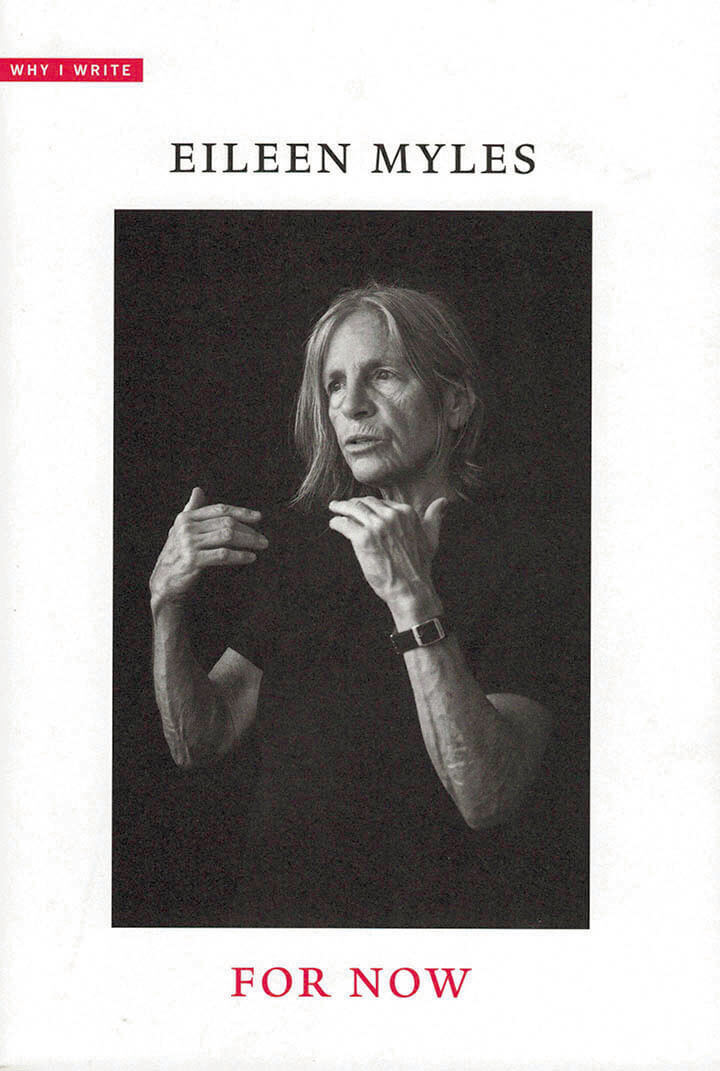
For Now
In this third Why I Write volume, Eileen Myles addresses the social, political, and aesthetic conditions that shape their work.
In this raucous meditation, Eileen Myles offers an intimate glimpse into creativity's immediacy. With erudition and wit, Myles recounts their early years as an awakening writer; existential struggles with landlords; storied moments with neighbors, friends, and lovers; and the textures and identities of cities and the country that reveal the nature of writing as presence in time.
For Myles, time's "optic quality" is what enables writing in the first place, as attention, as devotion, as excess. It is this chronologized vision that enables the writer to love the world as it presently is, lending love a linguistic permanence amid social and political systems that threaten to eradicate it. Irreverent, generous, and always insightful, For Now is a candid record of the creative process from one of our most beloved artists.

Translation is a Mode = Translation is an Anti-neocolonial Mode
Don Mee Choi is the author of three books of poetry and hybrid essays, and an award-winning translator of contemporary Korean women’s poetry. In this pamphlet, Translation is a Mode=Translation is an Anti-neocolonial Mode, she explores translation and language in the context of US imperialism—through the eyes of a “foreigner;” a translator; a child in Timoka, the made-up city of Ingmar Bergman’s The Silence; a child from a neocolony.
This pamphlet is part of UDP’s 2020 Pamphlet Series: twenty commissioned essays on collective work, translation, performance, pedagogy, poetics, and small press publishing. Each offers a different approach to the pamphlet as a form of working in the present, an engagement at once sustained and ephemeral.

More-than-Human
Lucia Pietroiusti, Marina Otero Verzier and 1 more
The More-than-Human reader brings together texts that reflect on the state of post-anthropocentric thinking today, by writers from a wide range of disciplines. Focusing on the ecologies and technologies of climate injustice and inequalities, as well as the destructive structures lurking within anthropocentrism, More-than-Human proposes complex entanglements, frictions, and reparative attention across species and beings.
Thinking past the centrality of the human subject, the texts that compose this reader begin to imagine networks of ethics and responsibility emerging not from the ideologies of old, but from the messy and complex liveliness around and beneath us.
Rather than attempting to be a comprehensive compendium on the topic (which would be virtually impossible), More-than-Human provides a cross-section of the breadth and vitality of a literary, scientific, and conceptual milieu where multiple strands of work intersect even as they are frequently regarded as belonging to separate disciplinary discourses.
Contributors: Stacy Alaimo, Ramon Amaro, Karen Barad, Rosi Braidotti, Octavia Butler, Georges Canguilhem, Marisol de la Cadena, NASA History Department, Silvia Federici, Scott F. Gilbert, Édouard Glissant, Jack Halberstam, Donna Haraway, Myra J. Hird, Kristina Lyons, Patricia MacCormack, John T. Maher, Michael Marder, Timothy Mitchell, Reza Negarastani, Jussi Parikka, Elizabeth Povinelli, Paul B. Preciado, María Puig de la Bellacasa, Filipa Ramos, Isabelle Stengers, Elly R. Truitt, Anna L. Tsing, Eduardo Vivieros de Castro, Jason Wallin, Kathryn Yusoff and Joanna Zylinska.

BEZNA
Irina Gheorghe, Florin Fleuras and 1 more
Bezna is darkly glowing dead thinking, cosmic pessimism, hairy autonomy, inner reptilians, limbo sighs, horrendous pink volumes, underground nematodes, happy dismemberment, haunting prehumanism, compassion crises, glowing horror, sinister moods, aesthetic autophagia, postspectacle shelters, eternal stillness, future plague, decomposing knowledge, ouroboric moves, idiot nonknowing, shadow bodies, netherworld excavations, imperceptible evil, hyperbolic specters and news from Cioran.
Bezna's first issues were edited by Florin Flueras, Veda Popovici and Arnold Schlachter, the last ones by Florin Flueras, Irina Gheorghe and mainly by Alina Popa, in the memory of which this anthology is published.
'Bezna' in Romanian means consistent darkness + diffuse fear
Edited by: Alina Popa, Florin Flueras, Irina Gheorghe, Veda Popovici, Arnold Șlahter, Claudiu Cobilanschi
Contributions by Roi Alter, Aparat Security, Aulos, Brynjar Abel Bandlien, Emil Cioran, Ciumafaiu, ClaudiuCobilanschi, Octavian-LiviuDiaconeasa, Valentina Desideri, Bogdan Draganescu, Ion Dumitrescu, Florin Flueraş, Irina Gheorghe, Amy Ireland, Sarah Jones, Anastasia Jurescu, Kroot Juurak, Deanna Khamis, Mihai Lukacs, Nicola Masciandaro, G.A. Neagu, Dorothee Neumann, Cosima Opartan, Paradis Garaj, Alina Popa, Veda Popovici, Arnold Slahter, Taulipang Indians of Guyana, The Bureau of Melodramatic Research, The Presidential Candidate, Eugene Thacker, Stefan Tiron, Dylan Trigg, Tea Tupajic, Akseli Virtanen, Ben Woodard.

Brush Fires in the Social Landscape
Brush Fires in the Social Landscape began in collaboration with the artist before his death in 1992 and first published in 1994, engaged those who Wojnarowicz would refer to as his tribe or community.
Now, on the twentieth anniversary of Brush Fires, when interest in the artist's work has increased exponentially, Aperture has expanded and redesigned this seminal publication to be even more inclusive. It is the only book that features the breadth of Wojnarowicz's work with photography.
The contributors, from artist and writer friends to the lawyer who represented him in his case against Donald Wildmon and the American Family Association, to the next generation of artists who were influenced by Wojnarowicz's sensibility, together offer a compelling, provocative understanding of the artist and his work.
Contributors include: Vince Aletti, Barry Blinderman, Cynthia Carr, David Cole, Shannon Ebner, Leonard Fink, Karen Finley, Nan Goldin, Félix Guattari, Wade Guyton, Melissa Harris, Elizabeth Hess, Tessa Hughes-Freeland, Peter Hujar, Fran Lebowitz, Lucy R. Lippard (introduction), Sylvère Lotringer, Carlo McCormick, Henrik Olesen, Wendy Olsoff, Adam Putnam, Tom Rauffenbart, James Romberger, Emily Roysdon, Marion Scemama, Gary Schneider, Amy Scholder, Kiki Smith, Andreas Sterzing, Zoe Strauss, Marvin J. Taylor, Lynne Tillman, and Wolfgang Tillmans.
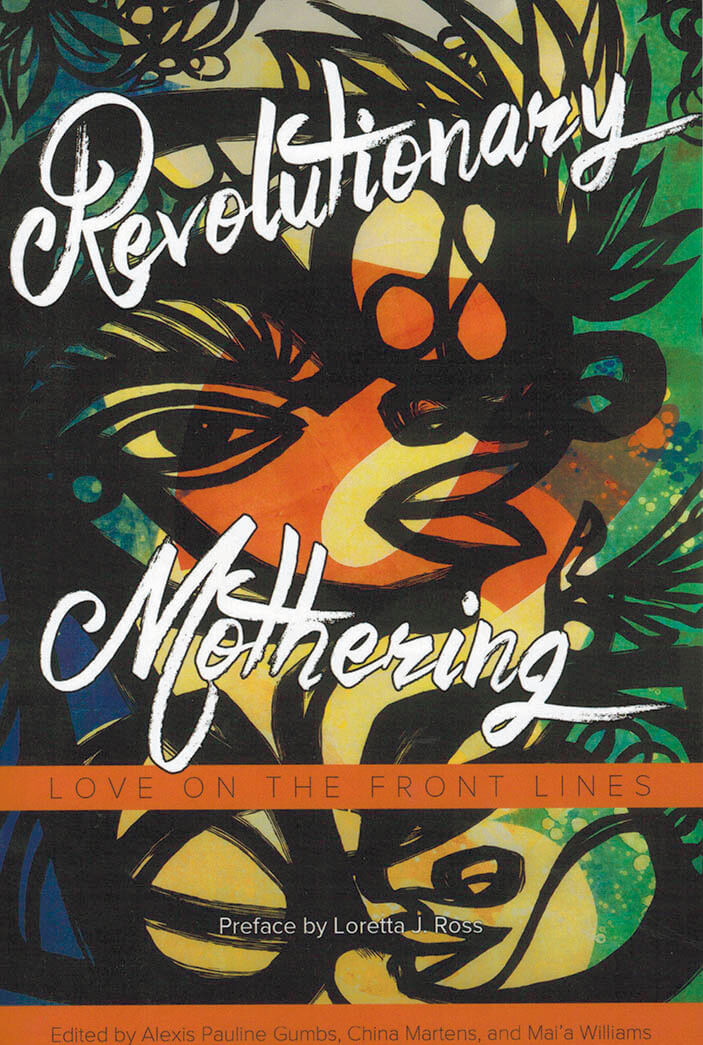
Revolutionary Mothering: Love on the Front Lines
Mai'a Williams, China Martens and 1 more
Revolutionary Mothering: Love on the Frontlines is an anthology that centers mothers of color and marginalized mothers' voices, women who are in a world of necessary transformation. The challenges faced by movements working for antiviolence, anti-imperialist, and queer liberation, as well as racial, economic, reproductive, gender, and food justice are the same challenges that marginalized mothers face every day.
Motivated to create spaces for this discourse because of the authors' passionate belief in the power of a radical conversation about mothering, they have become the go-to people for cutting-edge inspired work on this topic for an overlapping committed audience of activists, scholars, and writers. Revolutionary Mothering is a movement-shifting anthology committed to birthing new worlds, full of faith and hope for what we can raise up together.
Contributors include alba onofrio, Alexis Pauline Gumbs, Ariel Gore, Arielle Julia Brown, Autumn Brown, Cheryl Boyce-Taylor, China Martens, Christy NaMee Eriksen, Claire Barrera, Cynthia Dewi Oka, Esteli Juarez Boyd, Fabielle Georges, Fabiola Sandoval, Gabriela Sandoval, H. Bindy K. Kang, Irene Lara, June Jordan, Karen Su, Katie Kaput, Layne Russell, Lindsey Campbell, Lisa Factora-Borchers, Loretta J. Ross, Mai'a Williams, Malkia A. Cyril, Mamas of Color Rising, Micaela Cadena, Noemi Martinez, Norma A. Marrun, Panquetzani, Rachel Broadwater, Sumayyah Talibah, Tara CC Villaba, Terri Nilliasca, tk karakashian tunchez, Victoria Law, and Vivian Chin.
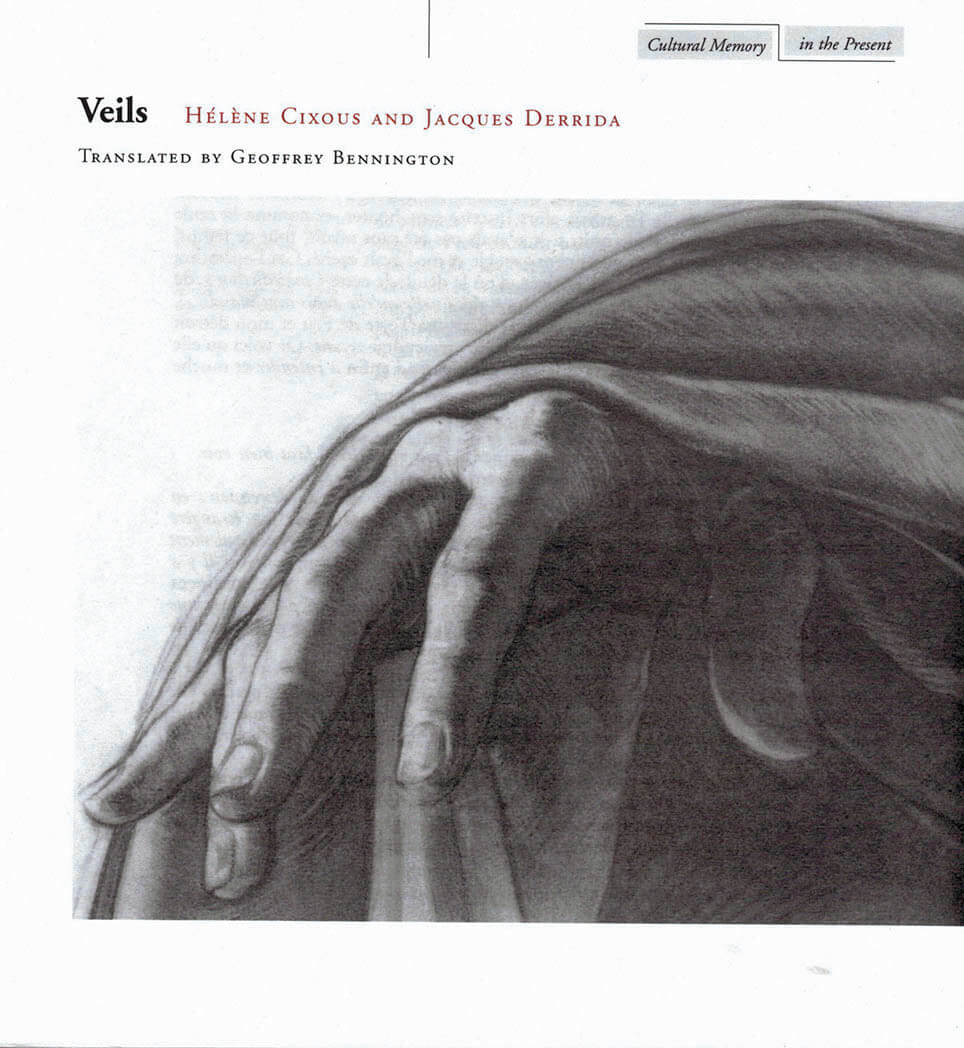
Veils
Hélène Cixous, Jacques Derrida
This book combines loosely "autobiographical" texts by two of the most influential French intellectuals of our time. "Savoir," by Hélène Cixous is an account of her experience of recovered sight after a lifetime of severe myopia; Jacques Derrida's "A Silkworm of One's Own" muses on a host of motifs, including his varied responses to "Savoir."
Hélène Cixous is Professor of Literature and Director of the Centre d'Etudes Feminines, Paris VIII. Jacques Derrida is Director of Studies at the Ecole des Hautes Etudes en Sciences Sociales, Paris, and Professor of Humanities at the University of California, Irvine. Stanford has published nine of his books, most recently Of Hospitality, which also includes a text by Anne Dufourmantelle (Stanford, 20
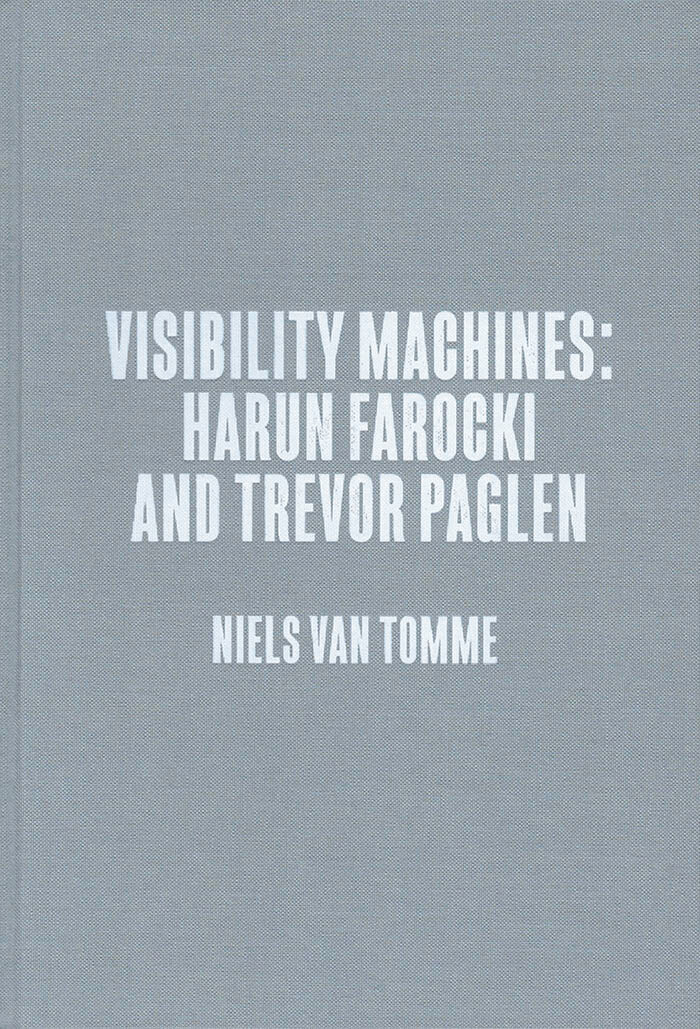
Center for Art, Design and Visual Culture
Visibility Machines: Harun Farocki and Trevor Paglen
Visibility Machines explores the unique roles that German filmmaker, video artist and author Harun Farocki (1944-2014) and American artist and author Trevor Paglen (born 1974) play as meticulous observers of global military operations. Investigating forms of surveillance, espionage and weaponry, Farocki and Paglen both examine the ways in which military activities transform and politicize our relationship to images and the realities they appear to represent.
The publication contains a number of newly commissioned essays by esteemed scholars who approach the work from diverse thematic perspectives, in addition to texts by Farocki and Paglen, as well as three exclusive visual essays exploring themes emerging from a dialogue between their work.
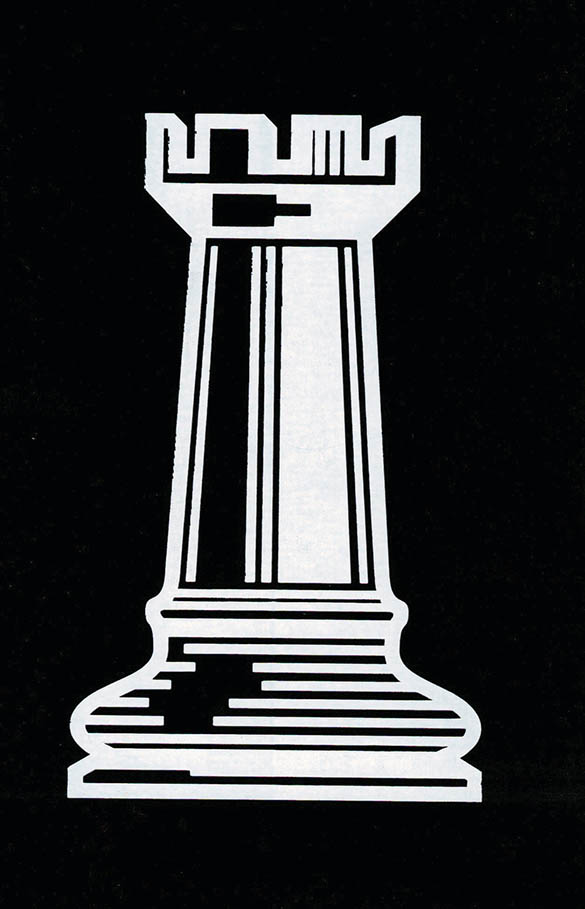
Insufficient Armour
A body of essays and visual contributions by radical theorists around the prosthesis and the "augmented body" issues.
"We all need means of supplementing our natural capabilities, since nature is indifferent, inhuman (extra-human), and inclement; we are born naked and with insufficient armour." — Le Corbusier
Once confined to the narrow circle of "medicalizing" practices, the prosthesis finally colonized our imagination thanks to the promise of an "augmented body" capable of undermining traditional dichotomies such as artificial vs. natural and organic vs. non-organic. But what are their speculative, theoretical and political repercussions? In this selection of original papers, the authors of Insufficient Armour reflect on the subject from their own peculiar perspectives, each of them contributing essays, political-philosophical analysis and theory fiction experiments.
Texts and contributions by Luigi Alberto Cippini, Matt Colquhoun, Helen Hester, Simon Sellars.

Voice of Hearing
A phenomenology of voice and hearing.
Contemplative, intricate, here the philosopher Vivian Darroch-Lozowski develops a phenomenology of hearing. Where theorizing is a present-tense action. Where a landscape teaches waiting. Where to be in a body is to gesture to another. Where subjectivity is the transformation of language. Where attention releases nascent energy. Where to hear is also to transform. Where myth is a gate. A close attending to this text, which is also a unicorn, will delicately open the reader's time-sense. —Lisa Robertson, author of Cinema of the Present, The Weather, Nilling, and The Baudelaire Fractal.
Vivian Darroch-Lozowski is Professor Emerita of the University of Toronto. Her writings and visual works cover different genres: scholarly, literary, creative non-fiction, artist books, painting/drawing and film. Her books include Notebook of Stone, Antarctica Body, Blue Cloud, Surface of the Living World, and The Uncoded World. Her recent project was returning 160 acres of agricultural land to natural prairie with wetlands. She lives in Moose Jaw, Treaty 4 Territory, Saskatchewan (Canada).
Published Nov 2020
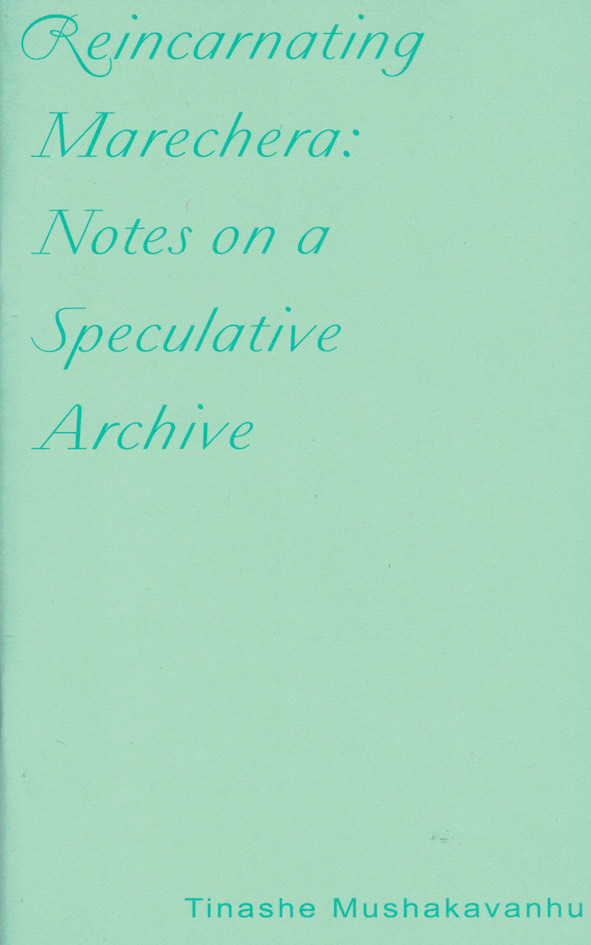
Reincarnating Marechera: notes on a Speculative Archive
Dambudzo Marechera’s death on August 18, 1987 is an event that remains unremarked. In Reincarnating Marechera: Notes On a Speculative Archive, Mushakavanhu interprets this event as a moment of radical praxis in the Zimbabwean imaginary, mining three overlapping archives—Marechera’s own writings, his historical and theoretical legacy, and an imaginative archive that responds creatively to gaps in the first two. Here, Mushakavanhu also explores the affective relationship between a critic and his object of study, grappling with the transit between the historical archive and the critical present. In doing so, through text and visuals, the book is a revelation of countless ruptures and of the inexhaustibility of documenting a mercurial subject like Marechera.
This pamphlet is part of UDP’s 2020 Pamphlet Series: twenty commissioned essays on collective work, translation, performance, pedagogy, poetics, and small press publishing. The pamphlets are available for individual purchase and as a subscription. Each offers a different approach to the pamphlet as a form of working in the present, an engagement at once sustained and ephemeral.
Tinashe Mushakavanhu is a Zimbabwean writer, scholar, and founding partner of Black Chalk & Co., a fugitive creative agency that operates between Harare and Richmond, VA. His most recent publication is Some Writers Can Give You Two Heartbeats (2019). He has also co-edited Visa Stories: Experiences Between Law and Migration (2013) and State of the Nation: Contemporary Zimbabwean Poetry (2009). He holds degrees from English, Welsh and Zimbabwean universities. He is currently a postdoctoral fellow at Wits Institute for Social and Economic Research (WiSER) at the University of Witwatersrand, South Africa.
Published July 2020

Enya: A Treatise on Unguilty Pleasures
Does music have to be smart or does it just have to go to the heart? In dazzling, erudite prose Chilly Gonzales’ musical memoir delves beyond the innumerable gold discs and millions of fans to excavate his own enthusiasm for Enya’s singular music and the mysterious musical herself, and along the way to uncover new truths about the nature of music, fame, success and the artistic endeavour.
Chilly Gonzales is one of the most exciting, original, hard-to-pin-down musicians of our time. Filling halls worldwide at the piano in his slippers and a bathrobe—in any one night he can be dissecting the musicology of an Oasis hit, giving a sublime solo recital, and displaying his lyrical dexterity as a rapper. In his book about Enya, he asks: Does music have to be smart or does it just have to go to the heart? In dazzling, erudite prose Gonzales delves beyond her innumerable gold discs and millions of fans to excavate his own enthusiasm for Enya’s singular music as well as the mysterious musician herself, and along the way uncovers new truths about the nature of music, fame, success and the artistic endeavour.
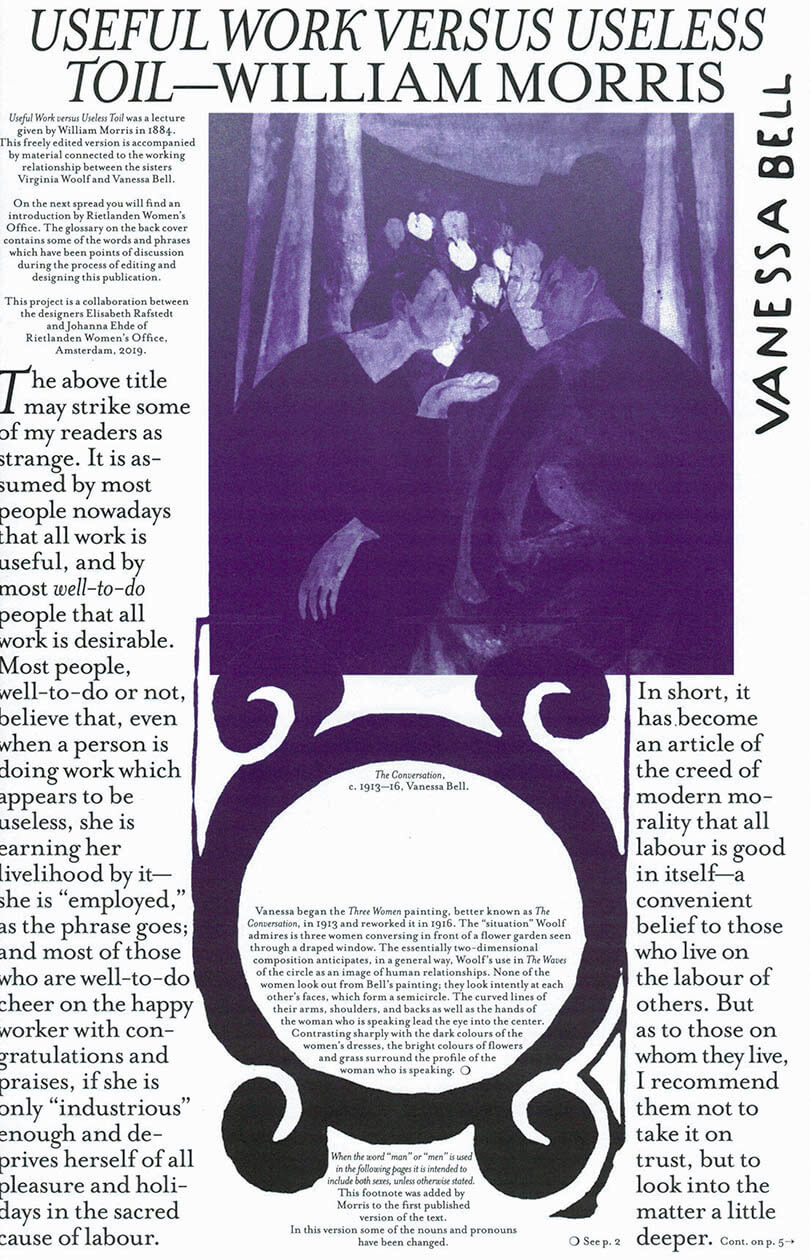
MsHERESIES 2 — USEFUL WORK VERSUS USELESS TOIL
Elisabeth Rafstedt, Johanna Ehde
The second issue of MsHeresies includes collages, paintings, and hommages to the work of sisters Vanessa Bell and Virginia Woolf, whose collaboration defied preconceived ideas of both text/image hierarchies, as well as rivalry at the cost of sisterhood. This visual essay is published alongside William Morris’s lecture Useful Work versus Useless Toil from 1884 which introduces the idea of the ornamental and its relationship to work and rest.
The ornamental can only come about under certain conditions: enough rest, agency, and variation of work. The ornamental is never an outcome or product of these conditions; but something intrinsically intertwined therein.

Blackfishing the IUD (Yellow Papers 3)
Excerpts from Caren Beilin’s 2019 essay/memoir about reproductive health and the IUD, gendered illness, medical gaslighting, and activism in the chronic illness community.
“The moon is hollow. The moon is hollow says a certain contingent of people, because of aliens (and, also, the moon has experienced bangs on its surface that have apparently made it ring just like a bell).
These people are conspiracy theorists. Paranoid, conclusive, certain. Too certain. They connect the dots with their eager, enormous chalk. They want something to be true. They want, I think, something new to be true, and they are taken (as I am) with the moon being like a bell, two phonemes, moon, bell, beautiful and struck across each other’s false armor, mutable and beautiful.
The moon is a bell, as the theorist Georges Bataille, in 1931, said, ‘The sun is an anus.’ He was arguing about the beauty – the absolute energy – of the copula.
‘The verb to be is the vehicle of amorous frenzy,’ he wrote, the year that Benjamin unpacked his library, alone. The moon is a bell, and I believe this absolutely, sure. The IUD is the RA. The sexual force of the verb, is, to be, of my verbacious being, will knock any noun into the moon and beyond. Everything is a parody, can be anything. The moon is hollow and made of muleskin. The moon is hollow, insofar as it is coated with the agglutinate, the shining coat, of a limit. I cannot go into the moon with my eyesight. I can’t enter my womb from that time (in November 2015) and sit crosslegged by the device, at the base of its suspending embedding, in the oaty red fist of my uterus, and watch the metal loam off its rigid cross-branch – and leech into tissues and activate, or reanimate, flare, or push over my problem. I can’t spy the center of the inception or the core of my being. I only know the timing. My health deteriorated rapidly after it was in, and I know how horrible it is, to cease planning for trips, outings, applications, or children, waiting and watching for how bad and how soon, and that the moon is hollow
This pamphlet excerpts from Blackfishing the IUD, published in 2019 by Wolfman Books, Oakland. With thanks to Caren Beilin, Jacob Kahn, and Justin Carder.
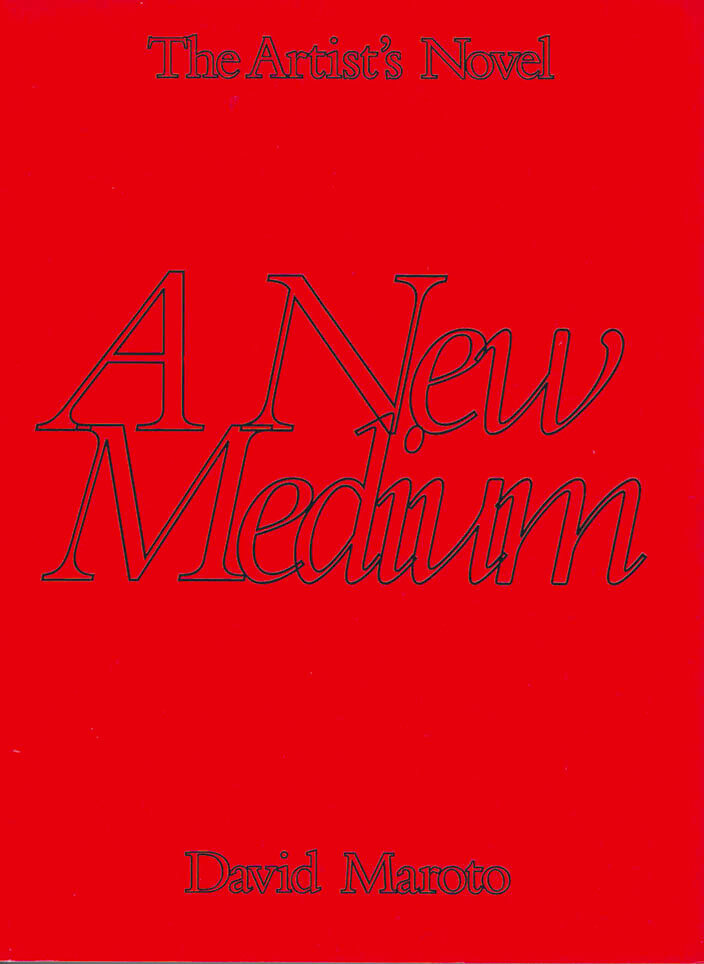
A New Medium
The first of a two-volume publication dedicated to the artist's novel, this theoretical essay aims to elucidate the pressing questions posed by the emergence of this new artistic medium with a number of key case studies and interviews.
Why do artists write novels? What impact does the artist's novel have on the visual arts? How should such a novel be experienced? In recent years, there has been a proliferation of visual artists who create novels as part of their broader art practice. They do so in order to address artistic issues by means of novelistic devices, favoring a sort of art predicated on process and subjectivity, introducing notions such as fiction, narrative, and imagination. In this sense, it is possible to see the novel as a new medium in the visual arts; yet very little is known about it. This two-volume publication is the first to explore in depth the subject of the artist's novel.
Part 1, A New Medium, is a theoretical examination that looks critically at the different ways contemporary artists employ the artist's novel, focusing mainly on four key case studies: Benjamin Seror's Mime Radio, Cally Spooner's Collapsing in Parts, Mai-Thu Perret's The Crystal Frontier, and Goldin+Senneby's Headless. It seeks to situate the artist's novel within the broader context of the visual arts in the hopes of sparking a much-needed discussion about a practice that has long been ignored by critical strands in art discourse. It includes valuable resources, such as the only existing bibliography of artists' novels.
Interviews with Benjamin Seror, Cally Spooner, Mai-Thu Perret, Goldin+Senneby, Francis McKee, Vivian Ziherl, Natasha Soobramanien, Clive Phillpot, Alex Cecchetti, Łukasz Gorczyca, Jan Jasiński.
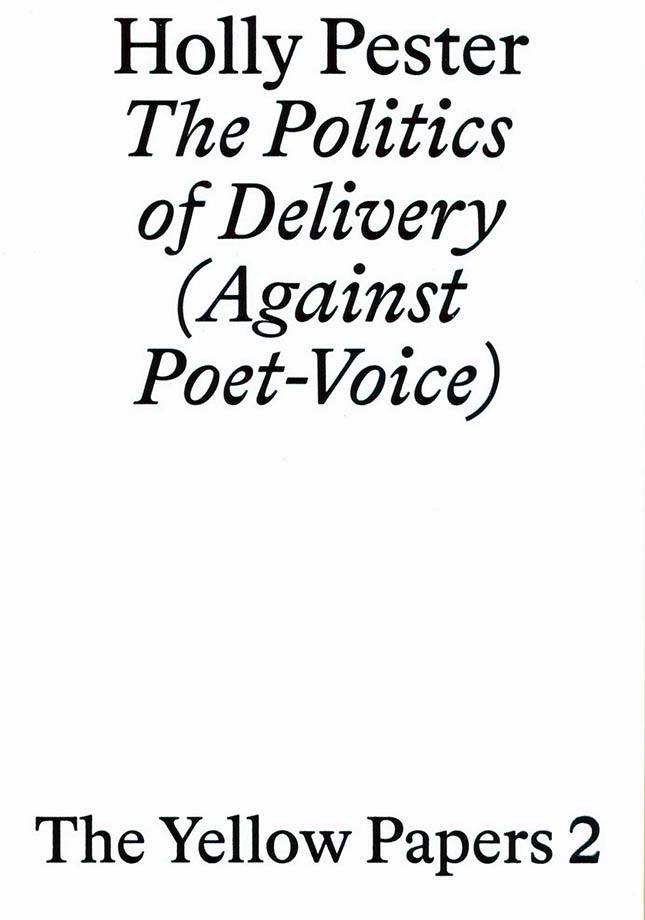
The Politics of Delivery (Against Poet-Voice)
An essay by Holly Pester on prosody, “poet-voice,” and the politics of delivery.
“Following a political impulse that I cannot shake, I want to oppose poet-voice. Not to smirk, but to suggest that poet-voice, that is, to lay a given mutual voice on top of the text, is a kind of opting out. It’s a self-absolving move. What’s being opted out of is the rough stuff of delivery and the ethical shrapnel in intonation. Such materials of poetic intonation are not, I will argue, irrelevant to the political questions of one’s speech in society and its disputed freedoms.
I have a fully felt and fraught relationship with delivery. I care about delivery compositionally; I enjoy the effects of composition working on and into my voice. Sometimes it feels as if my voice is the victim of some impossible contract with the text. The effort and timbres of delivery are therefore potentially very significant to a political poet. This sounded aspect of my work often gets short-handed as performance, but it’s not that. Performance art and performance poetry are distinct art forms with histories and styles, learned and studied by talented performers. Delivery is as banal or as eccentric as the material, but not necessarily correspondingly. It is part of the craft of poetry that isn’t unrelated to the intrinsic vocal identity of the poet (accent, etc.) yet has as much to do with tensions within the communities, heritages, and civics of poetry as with the individual. ”

Schismatics
Schismatics consists of 10 short stories, in a fictitious way dealing with forgotten historical personas. Among them, artist Goda Palekaitė includes Mary Anning –– an amateur discoverer of dinosaurs, Emanuel Swedenborg –– a mystic who empirically explored the architecture of heaven, and Essad Bey –– a Jewish-Muslim writer and orientalist. Here their lives are revived and balance between the lines of history and story.
The book fuses elements of fiction, academic writing, and artistic research, and intertwines with rumors, forgeries, and inventions. Previously, its characters and narratives have already appeared in Palekaitė’s performances and installations, which are presented in the middle of this bilingual edition. In the introductory essay, Valerio Del Baglivo analyses the author’s exploration of facts and fiction, the mechanisms of knowledge production, and the trans-chronological perception of time. At the end of the book, Monika Lipšic ‘Riddle’ reflects on a ‘schismatic poetics’.
Goda Palekaitė is a contemporary artist and researcher whose work combines visual, literary, performative, and anthropological practices. Exploring the politics of historical narratives, the agency of dreams and collective imagination, and social conditions of creativity, her work evolves around long-term projects that manifest as performances, scenographies, installations, and texts. Her performances, solo and group shows are being presented internationally. In 2019 Goda Palekaitė received The Golden Stage Cross and the Young Artist’s Prize for her artistic contributions across disciplines.
Published September 2020